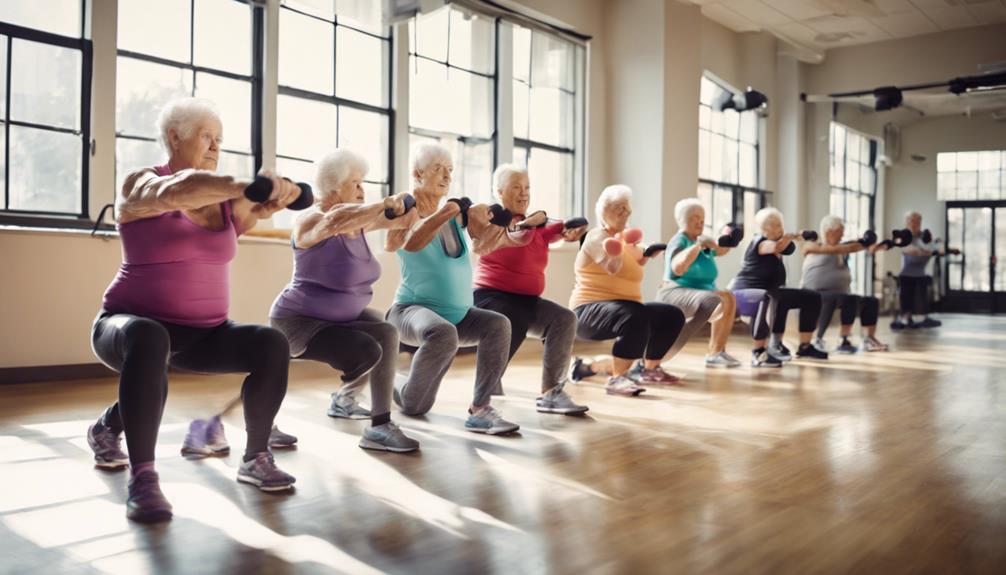To master moderate exercise for seniors, we focus on a mix of cardio, strength training, and safety. It boosts heart health, energy, and well-being, maintaining weight and immunity, reducing diseases, and enhancing strength, flexibility, balance, and coordination. Follow guidelines like chair yoga for flexibility, muscle strength, and joint pain relief, or join walking groups for socializing and motivation. Incorporate strength training for muscle mass, balance, independence, bone health, and fall prevention. Stay safe with low-impact activities, proper gear, hydration, and listening to your body. Seeking guidance guarantees effective routines and long-term health benefits. Learn more about mastering moderate exercise for seniors to boost overall well-being.
Key Takeaways
- Start with low-impact activities like walking or swimming.
- Incorporate strength training for muscle mass and balance.
- Monitor progress with a workout journal and wearable trackers.
- Seek professional guidance from a fitness trainer or healthcare professional.
- Focus on safety, hydration, and adjusting routines for long-term health.
Importance of Moderate Exercise for Seniors
Participating in regular moderate exercise is vital for seniors as it can greatly enhance their cardiovascular health, energy levels, and overall well-being. Engaging in activities like walking, swimming, or yoga can help improve blood circulation, strengthen the heart, and reduce the risk of chronic diseases such as heart disease, diabetes, and osteoporosis. By maintaining a healthy weight through exercise, seniors can also boost their immune system, making them more resilient against illnesses.
Moreover, moderate exercise plays an important role in promoting independence among older adults. It enhances mobility, flexibility, and muscle tone, ensuring that seniors can perform daily tasks with ease. Studies have shown that staying active not only benefits the body but also the mind. Seniors who engage in regular exercise experience better cognitive function, mood, and overall mental health, contributing to a higher quality of life. Essentially, incorporating moderate exercise into daily routines can greatly enhance the overall well-being of seniors.
Benefits of Moderate Exercise for Seniors
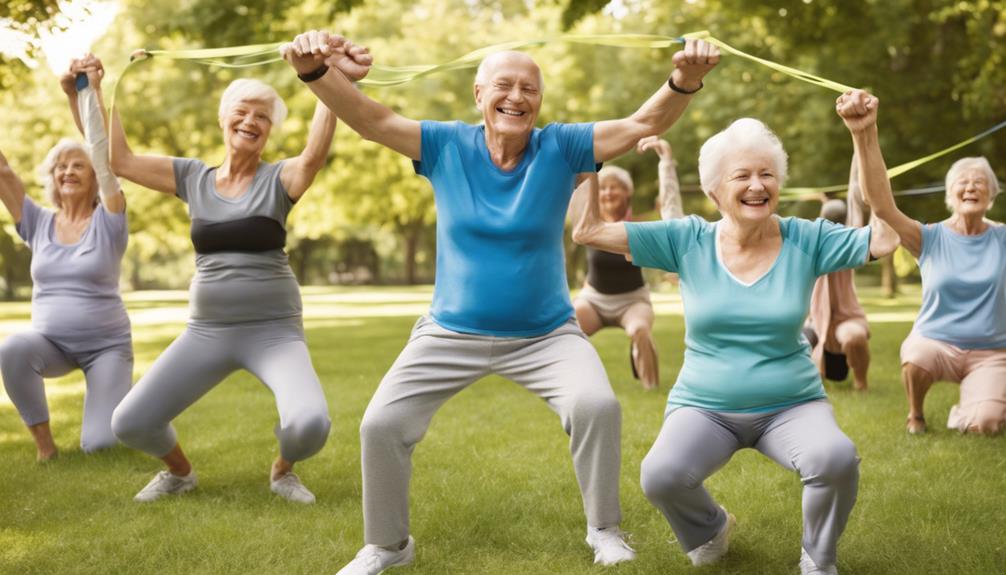
Moderate exercise for seniors offers a variety of health benefits that can greatly enhance overall well-being.
Engaging in regular physical activity can improve cardiovascular health, reduce the risk of chronic diseases, and help maintain a healthy weight.
Health Benefits Overview
Engaging in regular physical activity as a senior can bring significant health benefits, including improvements in cardiovascular health, muscle strength, and overall well-being. When active older adults incorporate moderate exercise into their routine, they can experience a variety of advantages, such as:
- Enhanced strength and flexibility, aiding in daily tasks
- Improved balance and coordination, reducing the risk of falls
- Better management of chronic conditions like heart disease and diabetes
- Increased overall well-being through mood enhancement and quality sleep
Physical Activity Importance
Improving heart health and reducing the risk of cardiovascular diseases, moderate exercise for seniors offers a range of significant benefits. Engaging in physical activity can improve muscle strength, enhancing overall mobility and reducing the risk of falls. It also helps in improving balance, which is vital for preventing accidents and injuries in older adults.
Regular moderate exercise is essential for reducing the risk of obesity-related health issues, as it aids in managing weight and promoting better overall health. Additionally, participating in moderate exercise can have positive effects on mental health by releasing endorphins, reducing stress, and improving mood.
Exercise Guidelines for Seniors
Regular physical activity for seniors offers a multitude of benefits, including reducing the risk of chronic diseases and improving overall well-being. When it comes to exercise guidelines for seniors, here are some key points to bear in mind:
- Moderate exercise can help lower the risk of chronic diseases like heart disease and diabetes.
- Improving cardiovascular health through moderate exercise leads to better circulation and reduced blood pressure.
- Maintaining a healthy weight is easier for seniors who engage in regular moderate exercise, lowering the risk of obesity and related health issues.
- Enhancing mental well-being is another benefit, as moderate exercise releases endorphins and reduces stress levels.
Guidelines for Moderate Exercise for Seniors
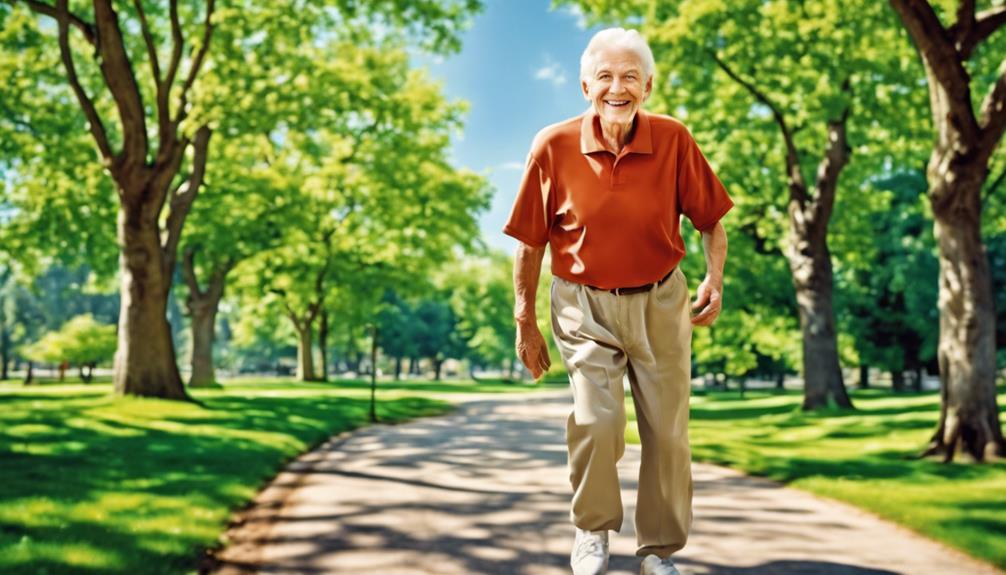
To achieve peak health benefits, seniors should aim for at least 150 minutes of moderate-intensity exercise per week. Engaging in activities like brisk walking, water aerobics, or cycling can help improve cardiovascular health, boost muscle strength, and reduce the risk of chronic diseases.
It's essential to spread out these moderate exercises throughout the week to maximize their benefits. By following these guidelines for moderate exercise, seniors can maintain their independence and enhance their overall well-being. Regular physical activity not only strengthens the body but also uplifts the spirit, leading to a more fulfilling and active lifestyle.
Types of Moderate Exercises for Seniors
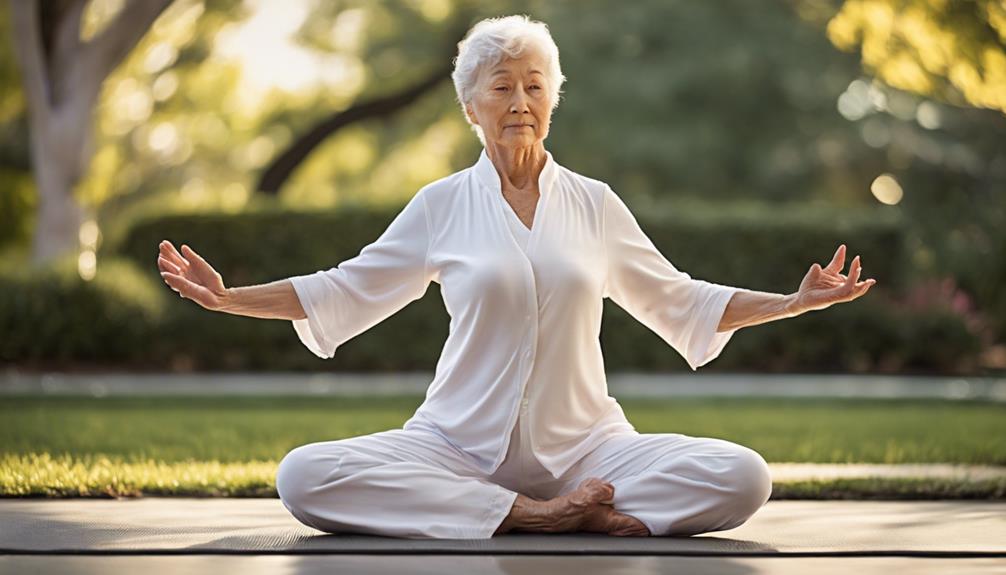
When it comes to types of moderate exercises for seniors, chair yoga offers benefits like improved flexibility and relaxation, while walking in a group can provide social interaction and motivation to stay active.
These activities cater to different preferences and fitness levels, making it easier for seniors to find an exercise that suits their needs and interests. Incorporating a variety of exercises can help seniors stay engaged and committed to their fitness routine.
Chair Yoga Benefits
Chair yoga, a gentle form of yoga that can be done while seated or with the support of a chair, offers numerous benefits for seniors with mobility issues. Here are some advantages of chair yoga for older adults:
- Improves flexibility, enhancing range of motion in joints.
- Enhances balance, reducing the risk of falls and injuries.
- Builds strength in muscles, aiding in daily activities.
- Alleviates joint pain, promoting comfort and mobility.
Engaging in chair yoga regularly can contribute to better posture, decreased stress levels, and an overall sense of well-being in seniors. This form of exercise is adaptable to various fitness levels and can be tailored to meet individual needs, making it a safe and effective option for older adults looking to enhance their physical and mental health.
Walking Group Benefits
Engaging in group walking sessions offers seniors a social, stimulating way to improve their physical and mental well-being through moderate exercise. Walking is an ideal low-impact aerobic activity for seniors, enhancing cardiovascular health and boosting mood. In addition to the health benefits of walking, these sessions provide an opportunity for seniors to connect with others, reducing feelings of isolation and fostering a sense of community. For those seeking to maintain their independence and personal safety at home, exploring the *top walk-in tubs for elderly* is crucial, as they offer enhanced accessibility and reduce the risk of slips and falls. Incorporating both safe physical activity like walking and supportive home modifications ensures a well-rounded approach to healthy aging. Additionally, the combination of regular group walking sessions and home modifications such as the **best walkin tubs for seniors** can greatly enhance seniors’ quality of life by promoting both mobility and safety. These walk-in tubs provide features like handrails and non-slip surfaces, offering peace of mind and reducing the risk of bathroom injuries. By prioritizing both social activity and a safe living environment, seniors can confidently maintain a healthy, active lifestyle while aging in place.
When done in a group, walking provides social interaction, motivation, and support, helping seniors maintain a consistent exercise routine. These group sessions not only promote physical health but also enhance mental well-being by reducing stress and fostering a sense of community among seniors.
In addition, walking in a group allows seniors to explore nature, breathe fresh air, and engage in physical activity in a safe and supportive environment. Joining a walking group can be a rewarding experience that benefits both the body and the mind of seniors.
Incorporating Strength Training for Seniors
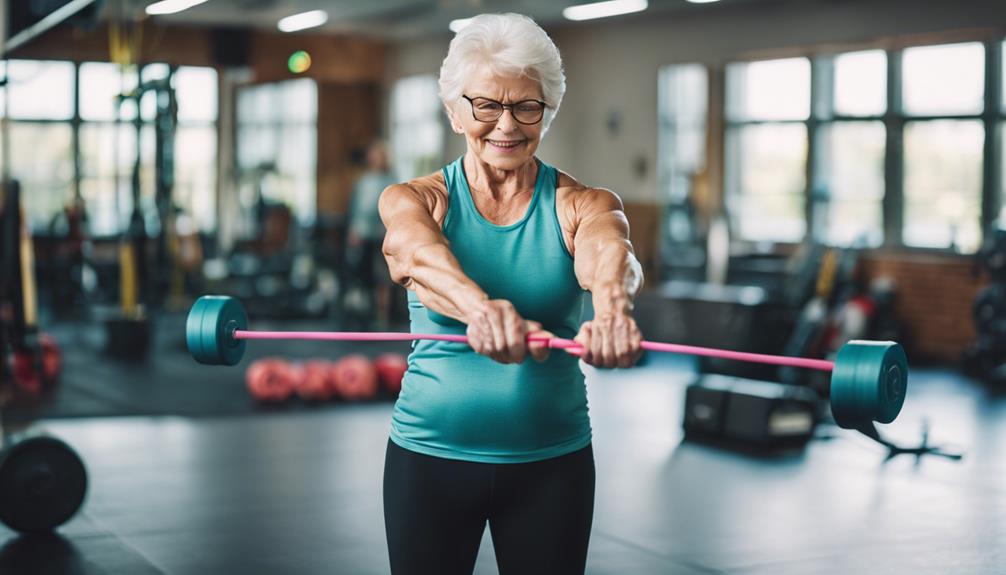
To enhance the benefits of moderate exercise for seniors, it's essential to incorporate strength training into their routine. Strength training plays an important role in maintaining muscle mass, which is particularly significant for seniors to prevent age-related muscle loss.
Here are some key points to keep in mind when integrating strength training for seniors:
- Improving Muscle Mass: Strength training helps seniors build and maintain muscle mass, which can contribute to overall strength and vitality.
- Enhancing Balance and Stability: By engaging in resistance exercises, seniors can improve their balance and stability, reducing the risk of falls and injuries.
- Promoting Independence: Regular strength training enables seniors to maintain their independence by enhancing their ability to perform daily tasks with ease.
- Supporting Bone Health: Including resistance exercises in a senior's routine can also enhance bone density, reducing the risk of conditions like osteoporosis.
Safety Tips for Senior Exercise
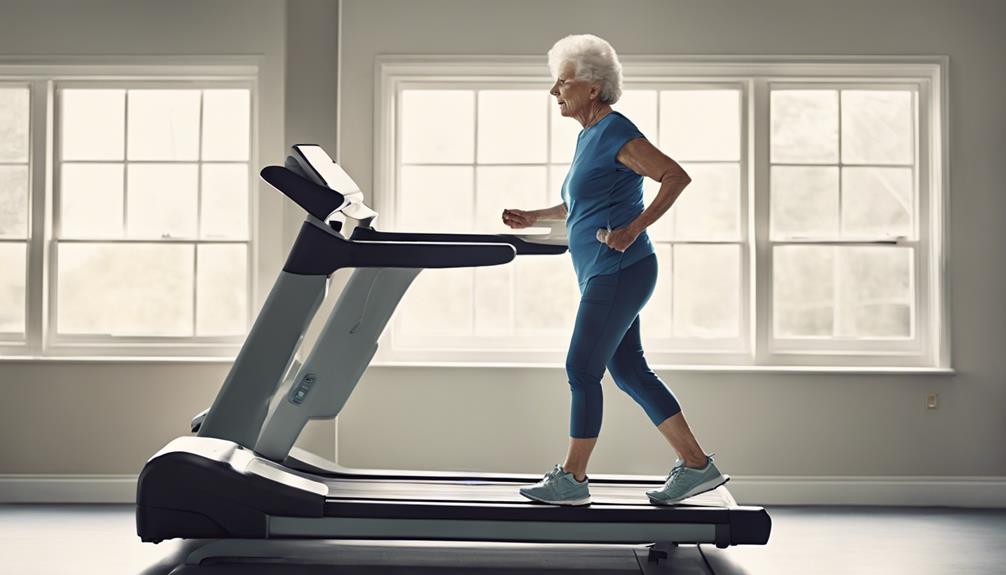
Incorporating strength training into a senior's workout regimen guarantees not only muscle maintenance but also establishes the foundation for discussing crucial safety tips for their exercises. When starting on an exercise program, seniors should prioritize safety to prevent injuries and ensure a rewarding workout experience. Here are some essential safety tips to take into account:
| Safety Tips | Description | Importance |
|---|---|---|
| Low-Impact Activities | Begin with gentle exercises like walking or swimming to protect joints and reduce injury risk. | Reduces risk of injury |
| Proper Gear | Use the correct equipment and footwear to provide support and stability during workout sessions. | Supports body during exercise |
| Stay Hydrated | Maintain hydration levels before, during, and after workouts for peak performance. | Prevents dehydration |
| Listen to Your Body | Pay attention to any discomfort or pain during exercise and stop if something feels wrong. | Reduces risk of injury |
Monitoring Progress and Adjusting Routines
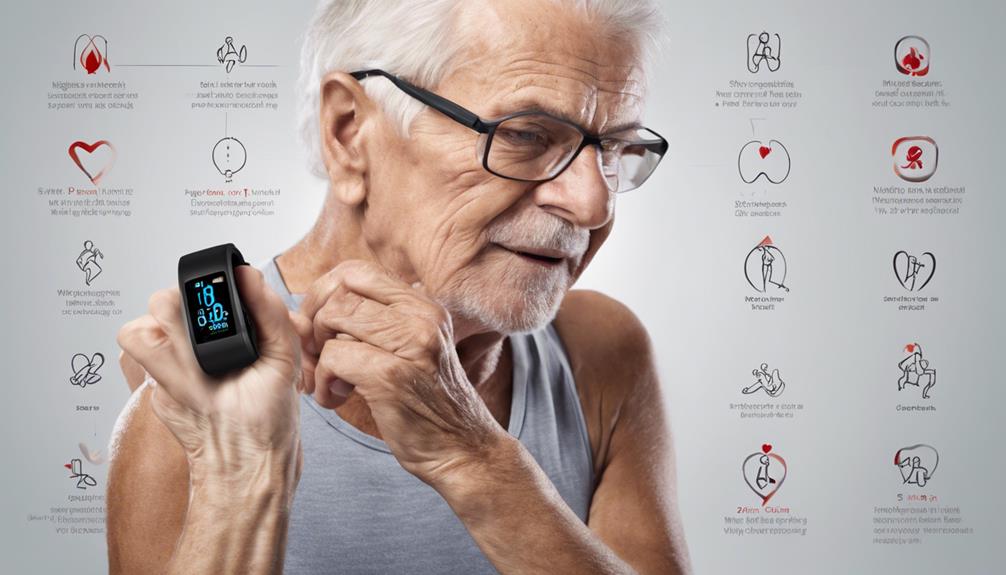
Monitoring progress and adjusting routines involves tracking exercise duration and intensity levels to accurately assess improvements in strength and endurance. To effectively monitor and adjust your exercise routine, consider the following:
- Exercises: Engage in a variety of exercises that target different muscle groups to promote overall strength and flexibility.
- Track: Keep a detailed workout journal to record your daily exercise activities, including sets, reps, and any modifications made.
- Adjust: Be ready to adapt your routines based on your fitness goals, energy levels, and feedback from your body.
- Progress: Celebrate small milestones and improvements in your performance to stay motivated and focused on your fitness journey.
Additionally, using wearable fitness trackers can provide valuable insights into your heart rate, calories burned, and daily activity levels. Remember to seek guidance from a fitness trainer or healthcare professional to make sure that your adjustments are safe and effective.
Frequently Asked Questions
What Is Moderate Exercise for Seniors?
We define moderate exercise for seniors as activities like brisk walking and light cycling that elevate heart rate and breathing. It should be somewhat challenging yet allow conversation. Engaging in such exercises enhances cardiovascular health, muscle strength, and mobility.
What Is the Best Workout Routine for Seniors?
We suggest a balanced routine for seniors, including aerobic, strength training, flexibility, and balance exercises. It's essential to aim for 150 minutes of moderate-intensity aerobic activity weekly, along with strength training twice a week to maintain muscle mass and prevent falls.
What Is the Number One Exercise to Do as You Get Older?
Walking wins as we age. It's gentle, versatile, and enhances our health. Regular walking boosts heart health, muscles, and weight management. This weight-bearing exercise fortifies bones and combats osteoporosis. Aim for 30 minutes most days!
What Are the Four Main Types of Exercise That Seniors Need to Stay Healthy?
To stay healthy as seniors, we need a mix of aerobic, strength, flexibility, and balance exercises. These activities improve heart health, maintain muscles and bones, enhance flexibility, and prevent falls. It's important to prioritize these for overall well-being.
Conclusion
To sum up, moderate exercise is essential for seniors to maintain their health and well-being. One example is Margaret, a 70-year-old who started incorporating moderate exercise into her routine and saw improvements in her strength and flexibility.
By following the guidelines, incorporating strength training, and staying safe, seniors can reap the many benefits of regular physical activity. Remember to monitor progress and adjust routines as needed to continue reaping the rewards of staying active.
